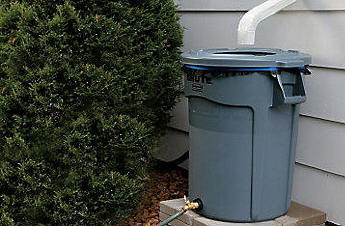(7/15) Many homeowners and gardeners have a rain barrel because it helps protect the health of local streams. But how can rain barrels do that, and what is the science behind it?
 A rain barrel is a container about the size and shape of a trash can. It connects with your gutter. Rain that falls on your roof funnels into the gutters and pours into the rain barrel. Later, a spigot near the bottom of the barrel allows you to use the stored water for your garden. It is an easy and convenient
way to water your garden and keep your bird baths filled. It is also a great way to keep local streams healthy.
A rain barrel is a container about the size and shape of a trash can. It connects with your gutter. Rain that falls on your roof funnels into the gutters and pours into the rain barrel. Later, a spigot near the bottom of the barrel allows you to use the stored water for your garden. It is an easy and convenient
way to water your garden and keep your bird baths filled. It is also a great way to keep local streams healthy.
Imagine that there is no rain barrel catching the water from your roof. The rain falls and flows over the land toward the nearest stream. This is called "storm water." The water picks up many things in its path – discarded seed packets, car oil, excess fertilizer and pesticide, dog waste, loose soil from a freshly dug flower bed, etc. These pollutants end up in streams
and can cause damage.
For example, fertilizer contains the nutrients nitrogen and phosphorus. In the garden, these nutrients help plants grow. It is no different in the water! Too many nutrients in a stream or pond can cause large amounts of algae to grow, called an algae bloom. The algae bloom blocks sunlight and other plants are unable to grow. Fish can become trapped in the tangle of
algae. As the algae breaks down, the bacteria eating the algae use up a lot of oxygen. When oxygen is low, fish and insects living in the water will find it difficult to breathe.
Soil is another example of a pollutant carried by storm water. In small amounts, soil is not a pollutant. It can be an important source of healthy nutrients for the stream. But when excess amounts of soil enters the water, it can be a problem. Soil can cover up habitats on the stream bottom. For fish, the soil particles can damage or clog gills (imagine trying to
breath during a sand storm!). Soil can also block sunlight, which is essential for under water plants to grow. Rain barrels help reduce the amount of pollutants that enter our local streams.
Storm water is nothing new. It is a natural part of the water cycle. When rain falls to the ground, some of it runs over the land into a river, and some soaks into the ground. In the past, a lot of the water soaked into the ground where it was filtered and slowly released into streams. Today we have increasing amounts of roads, driveways, parking lots, and buildings –
surfaces that water cannot soak into. More and more storm water is rushing over our land, picking up pollutants and carrying them to the streams. Rain barrels help to battle the increasing amount of storm water.
Besides rain barrels, there are several ways that homeowners and gardeners can help keep our local streams healthy. Install a settling pond that catches storm water and allows nature to filter out pollutants. Use a cover crop on your garden to prevent soil from washing away. Be sure to follow directions when applying chemicals so there is no excess. Plant trees or grow
a rain garden because both soak up water!
I know what you are thinking, "But I don’t live near a stream or pond." You do not need to be next to a stream to have an effect on it. We all live in a watershed – an area of land that drains into one body of water. In Adams County, we live in the Chesapeake Bay watershed. This means that any loose soil, fertilizers, or oil on your property could be carried over the
land into small streams that connect to Conewago Creek, the Susquehanna River, and all the way to the Chesapeake Bay. By installing a rain barrel, you not only protect your local streams but the larger rivers as well!
In a nutshell, rain barrels help stop pollution from getting into the water. Don’t have a rain barrel yet? They are easy and inexpensive to build. It may seem small in the grand scheme of storm water pollution, but all of the small efforts add up. Besides, what a convenient way to water your garden!